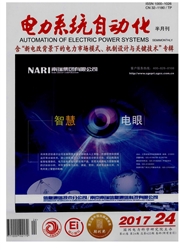

 中文摘要:
中文摘要:
在静态和动态信息的集成平台上,将安全分析功能从静态提升为动态,实现时空协调防御框架。为此,讨论信息的可靠性和动态数据采集点的优化布置;将实时信息和数值仿真结合,实现动态数据的深层挖掘。其核心功能是动态安全的定量评估技术,包括电流、功角、电压、频率的稳定裕度和低频振荡阻尼的评估,以及相应的灵敏度分析和稳定域估计。在此基础上,就可以按风险的概念实现在线预警、自适应优化的预防控制、继电保护、紧急控制、校正控制和恢复控制等各道防线的决策。
 英文摘要:
英文摘要:
Based on an integrated static/dynamic information platform, security analysis functions can be upgraded from static to dynamic aspect for the space-time cooperative framework proposed in the part Ⅰ of the three-part paper. This part investigates information reliability, optimal allocation of the dynamic data acquisition, data mining of field trajectories and/or simulation ones. The kernel functions of a dynamic energy management system (DEMS) are quantitative analyses of various securities, such as stability index and stability domain for thermal, angle, voltage, frequency and low frequency oscillation respectively. Based on these early-warning functions, adaptive optimization for preventive, emergency, corrective and recovery controls can be implemented with the connection between the DEMS and control equipments.
 同期刊论文项目
同期刊论文项目
 同项目期刊论文
同项目期刊论文
 Design and experiment of wide area HVDC supplementary damping controller considering time delay in C
Design and experiment of wide area HVDC supplementary damping controller considering time delay in C A Load Parameter Identification Method Based On Wide Area Trajectory Sensitivity. International Jour
A Load Parameter Identification Method Based On Wide Area Trajectory Sensitivity. International Jour 期刊信息
期刊信息
